雅思阅读新东方名师
新东方名师指导-雅思阅读复习策略
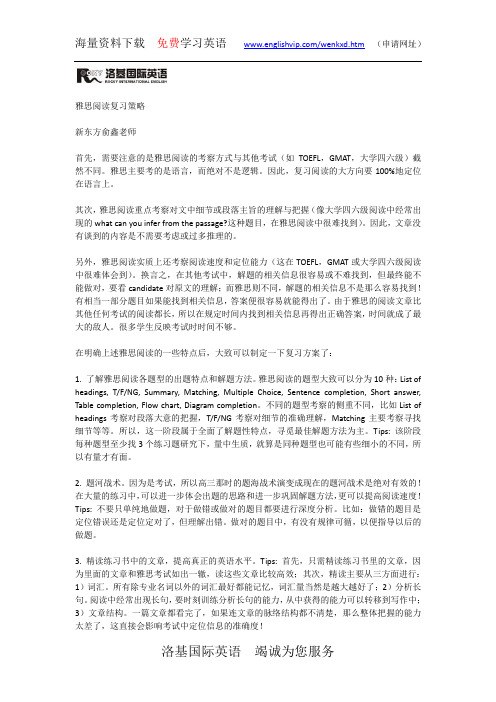
雅思阅读复习策略新东方俞鑫老师首先,需要注意的是雅思阅读的考察方式与其他考试(如TOEFL,GMAT,大学四六级)截然不同。
雅思主要考的是语言,而绝对不是逻辑。
因此,复习阅读的大方向要100%地定位在语言上。
其次,雅思阅读重点考察对文中细节或段落主旨的理解与把握(像大学四六级阅读中经常出现的what can you infer from the passage?这种题目,在雅思阅读中很难找到)。
因此,文章没有谈到的内容是不需要考虑或过多推理的。
另外,雅思阅读实质上还考察阅读速度和定位能力(这在TOEFL,GMAT或大学四六级阅读中很难体会到)。
换言之,在其他考试中,解题的相关信息很容易或不难找到,但最终能不能做对,要看candidate对原文的理解;而雅思则不同,解题的相关信息不是那么容易找到!有相当一部分题目如果能找到相关信息,答案便很容易就能得出了。
由于雅思的阅读文章比其他任何考试的阅读都长,所以在规定时间内找到相关信息再得出正确答案,时间就成了最大的敌人。
很多学生反映考试时时间不够。
在明确上述雅思阅读的一些特点后,大致可以制定一下复习方案了:1. 了解雅思阅读各题型的出题特点和解题方法。
雅思阅读的题型大致可以分为10种:List of headings, T/F/NG, Summary, Matching, Multiple Choice, Sentence completion, Short answer, Table completion, Flow chart, Diagram completion。
不同的题型考察的侧重不同,比如List of headings考察对段落大意的把握,T/F/NG考察对细节的准确理解,Matching主要考察寻找细节等等。
所以,这一阶段属于全面了解题性特点,寻觅最佳解题方法为主。
Tips: 该阶段每种题型至少找3个练习题研究下,量中生质,就算是同种题型也可能有些细小的不同,所以有量才有面。
新东方雅思9分阅读_Article 6_Building_up_steam_in China

Para 8
challenging
Key Sentences
① This unprecedented mass migration is the driving force behind tipping the demographics of world population distribution.
features.
④ His plan combines the best features of the earlier proposals. ⑤ Her eyes are her best feature. ⑥ Tonight's feature is a new romantic comedy.
Multiple Choice (Diagrams& More than One Answer)
1. Read instructions 2. Understand the diagrams.
⑩ The price of these buildings is obviously astronomical.
11 The cost to the environment and society due to this construction boom is even more alarming than the financial expense. 12 In regard to the economy, many fear that this real estate bubble will burst and have devastating effects. 13 Yung Ho Chang, one of China’s most prominent architects and head of the architecture department in MIT, aired his views on Chinese architecture in an interview with Business Week magazine.
【推荐】雅思阅读名师课堂讲义分享(第一章)-实用word文档 (1页)

【推荐】雅思阅读名师课堂讲义分享(第一章)-实用word文档本文部分内容来自网络整理,本司不为其真实性负责,如有异议或侵权请及时联系,本司将立即删除!== 本文为word格式,下载后可方便编辑和修改! ==雅思阅读名师课堂讲义分享(第一章)第1章 IELTS 中关于阅读文章中是非判断题分析1.1 是非题中关于 only 题的总结总结:剑4、5、6中共有 only 题7小题,5题 F ,2题 NG ,剑7中共有 only 题4小题3 F ,1 T . F 机率远大于 NG 及 T1.2 是非题中关于比较级的总结剑7中比较级考点共计4小题1 F ,2 NG ,1 T剑4.5.6比较级考点共计20小题,6 T ,10 NG ,4 F总结: NGF1.3 是非判断题中同级比较的总结剑4.5.6共计 the same as 题4道2 T ,1 NG ,1 F剑7共计2题同级比较,1 T ,1 F总结:剑4.5.6.7 阅读真题中同级比较考点无规律可循1.4 剑桥 IELTS 阅读文章中是非判断题解决方法1、是非判断题的出题顺序与其在原文中定位句的顺序是一致的,所以做此类题时必须有方向感,即 Q 1题在文中定位要在 Q 2前边, Q 2题在原文中定位句要在 Q 3原文定位处前边例如:剑5, P 23, T 1 P 2 Q 26 题目中独特定位词为 sociobiology ,在 para . F 和 para . I 中都出现了,第一次出现是在 Q 25题原文定位处的前面,第二次出现在 Q 25题原文定位处的后面,因为 Q 25与 Q 26两题具有顺序性,所以 Q 26题的答案应在原文 Q 25题原文定位处的后面的 para . I 中定位,而不是在 Q 25题原文定位处的前面的para . F 找答案。
《新东方IELTS9分阅读》怎么样?非常适合自学

【雅思书评】《新东方IELTS9分阅读》怎么样?非常适合自学
之前点评的阅读类的书比较少,所以今天帮大家带来的就是一本关于雅思阅读书籍的点评,可能很多同学都见过这本书,新东方出的《新东方IELTS
9分阅读》。
准确的说,新东方只是负责翻译,这本书的作者是一个来自英国的雅思考官,有十余年的留学培训考试经验。
这本书非常适合自学的考生,推荐理由见下文。
这本书一共四个章节,第一章阅读介绍和诊断测试。
这里面有个常见问题集,汇总了十个雅思老师对于学生常见问题的解答。
然后是阅读自学指南,告诉大家十个很好的学习习惯,像使用英语词典,大量阅读,如何控制时间等等,都是自学入门学习方法的一些基础常识。
然后那个诊断测试就是一套雅思阅读题,然后对答案的时候哪些部分做错了,它会直接让你到相应的页面去看针对这道错题的题型介绍和阅读技巧。
第二章是详细讲解不同题型的做题技巧。
六大题型都覆盖了,而且讲得很详细,每种题型都告诉你具体到每一步该做什么思考什么,而且还有大量的答题技巧,非常实用。
第三章是两套阅读模拟测试题和答案,最后一章是40多页的核心词汇。
每个单词都有例句,方便记忆。
总之这本书以讲解为主,并不是什么练习册。
中英双语,如果英语水平特别好的话直接看英文原版吧,新东方的翻译总是让人感觉有点奇怪,就不能好好说话。
大家根据自己的需求来吧,如果你急需新手入门指南,那雅思考官写得这本书是不二之选;如果你已经对阅读考试非常了解,想找些题来练手,那就省下三十块钱买别的吧。
首战7分背后的秘密
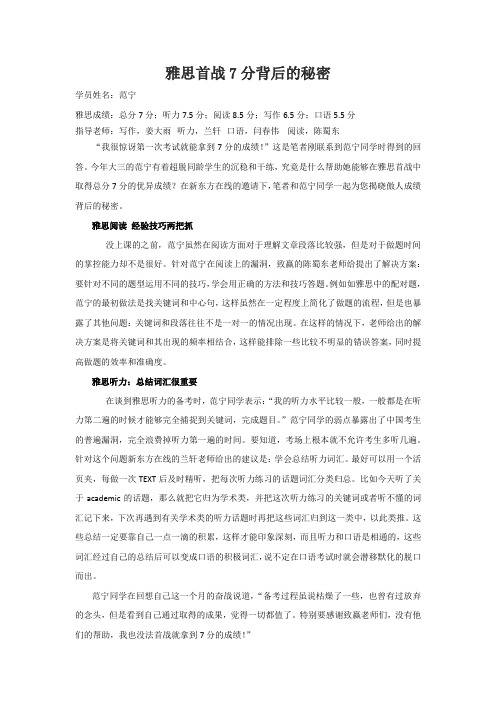
雅思首战7分背后的秘密学员姓名:范宁雅思成绩:总分7分;听力7.5分;阅读8.5分;写作6.5分;口语5.5分指导老师:写作,姜大雨听力,兰轩口语,闫春伟阅读,陈蜀东“我很惊讶第一次考试就能拿到7分的成绩!”这是笔者刚联系到范宁同学时得到的回答。
今年大三的范宁有着超脱同龄学生的沉稳和干练,究竟是什么帮助她能够在雅思首战中取得总分7分的优异成绩?在新东方在线的邀请下,笔者和范宁同学一起为您揭晓傲人成绩背后的秘密。
雅思阅读经验技巧两把抓没上课的之前,范宁虽然在阅读方面对于理解文章段落比较强,但是对于做题时间的掌控能力却不是很好。
针对范宁在阅读上的漏洞,致赢的陈蜀东老师给提出了解决方案:要针对不同的题型运用不同的技巧,学会用正确的方法和技巧答题。
例如如雅思中的配对题,范宁的最初做法是找关键词和中心句,这样虽然在一定程度上简化了做题的流程,但是也暴露了其他问题:关键词和段落往往不是一对一的情况出现。
在这样的情况下,老师给出的解决方案是将关键词和其出现的频率相结合,这样能排除一些比较不明显的错误答案,同时提高做题的效率和准确度。
雅思听力:总结词汇很重要在谈到雅思听力的备考时,范宁同学表示:“我的听力水平比较一般,一般都是在听力第二遍的时候才能够完全捕捉到关键词,完成题目。
”范宁同学的弱点暴露出了中国考生的普遍漏洞,完全浪费掉听力第一遍的时间。
要知道,考场上根本就不允许考生多听几遍。
针对这个问题新东方在线的兰轩老师给出的建议是:学会总结听力词汇。
最好可以用一个活页夹,每做一次TEXT后及时精听,把每次听力练习的话题词汇分类归总。
比如今天听了关于academic的话题,那么就把它归为学术类,并把这次听力练习的关键词或者听不懂的词汇记下来,下次再遇到有关学术类的听力话题时再把这些词汇归到这一类中,以此类推。
这些总结一定要靠自己一点一滴的积累,这样才能印象深刻,而且听力和口语是相通的,这些词汇经过自己的总结后可以变成口语的积极词汇,说不定在口语考试时就会潜移默化的脱口而出。
新东方胡敏谈雅思考试实录
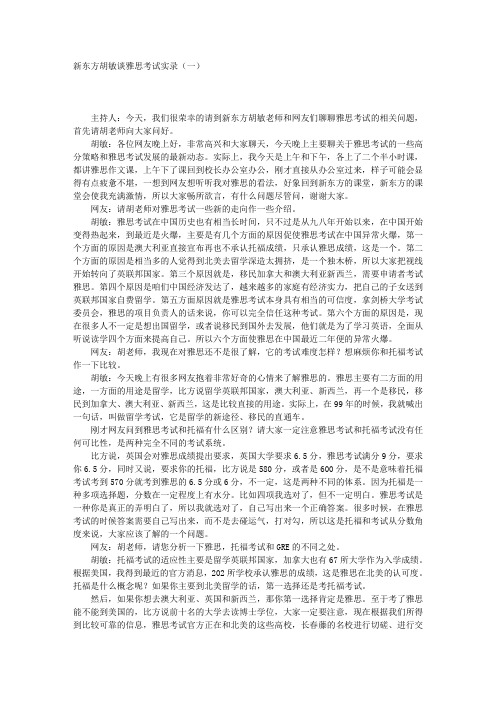
新东方胡敏谈雅思考试实录(一)主持人:今天,我们很荣幸的请到新东方胡敏老师和网友们聊聊雅思考试的相关问题,首先请胡老师向大家问好。
胡敏:各位网友晚上好,非常高兴和大家聊天,今天晚上主要聊关于雅思考试的一些高分策略和雅思考试发展的最新动态。
实际上,我今天是上午和下午,各上了二个半小时课,都讲雅思作文课,上午下了课回到校长办公室办公,刚才直接从办公室过来,样子可能会显得有点疲惫不堪,一想到网友想听听我对雅思的看法,好象回到新东方的课堂,新东方的课堂会使我充满激情,所以大家畅所欲言,有什么问题尽管问,谢谢大家。
网友:请胡老师对雅思考试一些新的走向作一些介绍。
胡敏:雅思考试在中国历史也有相当长时间,只不过是从九八年开始以来,在中国开始变得热起来,到最近是火爆,主要是有几个方面的原因促使雅思考试在中国异常火爆,第一个方面的原因是澳大利亚直接宣布再也不承认托福成绩,只承认雅思成绩,这是一个。
第二个方面的原因是相当多的人觉得到北美去留学深造太拥挤,是一个独木桥,所以大家把视线开始转向了英联邦国家。
第三个原因就是,移民加拿大和澳大利亚新西兰,需要申请者考试雅思。
第四个原因是咱们中国经济发达了,越来越多的家庭有经济实力,把自己的子女送到英联邦国家自费留学。
第五方面原因就是雅思考试本身具有相当的可信度,拿剑桥大学考试委员会,雅思的项目负责人的话来说,你可以完全信任这种考试。
第六个方面的原因是,现在很多人不一定是想出国留学,或者说移民到国外去发展,他们就是为了学习英语,全面从听说读学四个方面来提高自己。
所以六个方面使雅思在中国最近二年便的异常火爆。
网友:胡老师,我现在对雅思还不是很了解,它的考试难度怎样?想麻烦你和托福考试作一下比较。
胡敏:今天晚上有很多网友抱着非常好奇的心情来了解雅思的。
雅思主要有二方面的用途,一方面的用途是留学,比方说留学英联邦国家,澳大利亚、新西兰,再一个是移民,移民到加拿大、澳大利亚、新西兰,这是比较直接的用途。
新东方雅思老师心得体会

新东方雅思老师心得体会做为一个长期从事雅思教育工作的老师,我多年来一直秉持着让学生能够“学好雅思,用好雅思”的初衷。
在这个过程中,我不断总结和反思,不断寻求新的教学方法和策略,力求让学生在竞争日益加剧的雅思考试中脱颖而出。
下面是我多年来的一些教学心得体会,与大家分享。
一、基础扎实是关键在我看来,最基本的一点就是学习者的英语基础一定要扎实,才能快速地掌握雅思考试的各个考察项目。
初学者应该逐步加深词汇量,大力训练听力、阅读、写作和口语技能。
应该注重学习英语的语法、语音和拼写,提高对词汇和语法的理解和把握。
通过大量练习提高步入熟练阶段,然后再进入高分段。
二、科学的备考策略学习者要懂得制定科学的备考策略,转变自己的考试心态。
对于初学者,应该首先了解雅思考试的基本信息和知识点,比如考试时间、考试种类、考试难度等,然后开启自己的备考模式,为自己制定具体的备考计划和目标。
对于已经有了雅思基础的学员,要抓住各项考试项目进行针对性复习,同时要加强冲刺阶段的练习,保持对考试的细致认真和严谨态度,避免出现一些因为大意而犯的低级错误。
三、实现个性化教学对于教师来说,要抓住每个学生的弱势点并给出具体针对性的建议,根据每个学生的不同情况,制定个性化的学习计划,提高学生的学习效果,这是一种高效的教学模式。
对于雅思口语能力较弱的考生,可以修炼自己的表达能力,在日常范围内大声朗读,增强口腔活动,大多训练对口语的能力有一定提高;对于写作考试,可以让学生多看多写,并结合语法知识,速度与准确性应该是相对平衡的,即能在规定时间内写完规定的字数。
四、灵活运用教育资源在目前有互联网的时代,老师和学生都可以充分利用网络资源,大力宣传网络课程、免费视频课程、微信号等教育资源。
同时,课堂上,我也经常通过讲述个人学习经验、解答学生疑问等方式,帮助学生构建起学习思路和方法。
我还会鼓励学生自主学习,发挥学生的主动性和创造力,充分发挥每个人的潜力。
五、态度和氛围在教学过程中,我经常强调雅思考试不仅是一道考试,更是重要的人生体验。
【7A文】暑期雅思阅读课讲义完整版
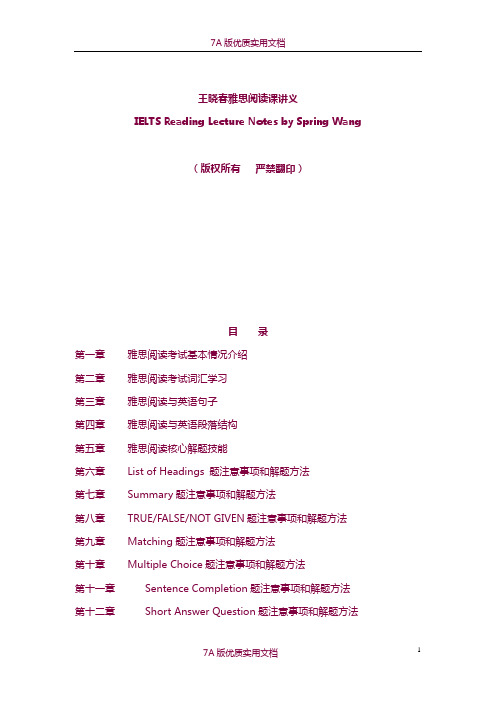
王晓春雅思阅读课讲义IELTS Reading Lecture Notes by Spring Wang(版权所有严禁翻印)目录第一章雅思阅读考试基本情况介绍第二章雅思阅读考试词汇学习第三章雅思阅读与英语句子第四章雅思阅读与英语段落结构第五章雅思阅读核心解题技能第六章List of Headings 题注意事项和解题方法第七章Summary题注意事项和解题方法第八章TRUE/FALSE/NOT GIVEN题注意事项和解题方法第九章Matching题注意事项和解题方法第十章Multiple Choice题注意事项和解题方法第十一章Sentence Completion题注意事项和解题方法第十二章Short Answer Question题注意事项和解题方法第十三章Table/Diagram/Flow Chart题注意事项和解题方法第十四章最新仿真阅读材料附录第一章雅思阅读考试基本情况介绍雅思考试(IELTS)考试的全称是:International English Language Testing System(国际英语语言测试系统)。
它是由剑桥大学地方考试委员会,英国文化委员会和澳大利亚教育国际开发署共同举办的国际英语考试。
考题主要是由剑桥大学地方考试委员会出,英国文化委员会和澳大利亚教育国际开发署主要负责一些考务管理方面的事情。
雅思考试是针对去英语国家留学或移民人员的一种语言能力的测试。
接受雅思成绩的国家以前是以英联邦和欧洲为主。
而现在北美也越来越多地接受雅思成绩。
雅思考试分为Academic Module(学术类考试,简称A类考试)和General Training Module(普通培训类考试,简称G类考试)。
A类主要是为留学,G类主要是为移民。
两类考试的听力和口语部分完全一致,但在阅读和写作部分有所区别。
A类阅读考试●考试时间为60分钟。
要特别注意的是:听力部分的考试会在结束后专门提供10分钟的时间用于誊写答案。
学会无词阅读 雅思阅读名师祁连山谈备考

学会无词阅读雅思阅读名师祁连山谈备考学会无词阅读雅思阅读名师祁连山谈备考学会无词阅读雅思阅读名师祁连山谈备考今年雅思的变化今年雅思的主要变化就是取消了3个月考试间隔的限制,这一变化主要是和新托福进行竞争,因为9月份新托福将在中国进行第一次考试,新托福这次出题特别难,相对来说认可度大概会高一点,而雅思取消考试时间间隔后带来的结果就是题目更新的速度可能会快一些,题库会不断地补充一些新题,但题型不会变,难度应该说也是比较恒定的。
总体来说,今年雅思的变化不是特别大,阅读方面也没有特殊的变化。
如何备战雅思阅读我们国内的考试都是精读而雅思考试是快速阅读,用一个比喻来形容二者,精读好比是逛街而快速阅读是购物,如果是购物的话,就要开出购物清单带着很强烈的目标去阅读,而精读就像逛街一样漫无目的,这就是差别。
我们已经习惯逛街了那怎么去购物呢?第一、先想清楚自己要买什么,这就是要预想答案的性质,第二是划出关键词,就是开出购物清单。
因为雅思阅读的关键因素就是速度,要想提高雅思阅读成绩两个速度必须提高,一是阅读速度,二是做题速度。
我研究出一种方法叫无词阅读法,什么是无词阅读法呢?并不是一个词都不认识瞎蒙。
我曾经问过一些学生阅读的时候认识的单词多还是不认识的单词多,他们仔细的想了想说还是认识的单词多。
事实上,阅读时有80%的单词我们是认识的。
只有20%的单词不认识,阅读就没法进行了吗?我的观点是:如果你的阅读要拿6分,只需具备四级词汇就可以了,考到7分,具备六级词汇就够了,无词阅读法就是把你需要的单词压缩到最低程度,利用你现有的单词储备一定可以够用,忽略一些生词的存在。
要想提高阅读速度和做题速度要抓两方面,一方面要研究如何快速阅读,一方面就要知道如何快速做题。
阅读速度方面环球雅思有两种课程,一种是基础阅读课,一种是强化阅读课,基础阅读提高的是阅读速度,强化阅读提高的是做题速度。
快速阅读要具备两个基本功能,一个是查找细节,一个是掌握主旨,在我的课上主要是教学生如何查找细节,如何掌握主旨,尤其以掌握主旨为主要目标,因为阅读同学们最害怕的是单词,我就要训练他们得意忘形。
IELTS-A类阅读-教材(全)

IELTS-A类阅读-教材(全)IELTS-A类阅读-教材(全)雅思写作A类阅读理解讲义主讲:乐静北京新东方学校欢迎使用新东方在线电子教材雅思整体介绍:INTRODUCTION TO IELTSIELTS is a testing system which assesses how good a person's English language is for the purpose of study or training. The test is recognised around the world by universities and colleges.There are two forms to the test:Academic: which tests a person's language for university studyGeneral Training: which tests basic languageskills with education or immigration in mindThere are 4 parts to each test. The Listening and Speaking tests are the same for both Academic and GeneralTraining forms of the test. There are separate papers for the Reading and Writing tests. The organisation looks like this:Listening4 sections, 40 questionsapproximately 30 minutes↙↘Academic Reading General Training Reading3 sections, 40 questions 3 sections, 40 questions1 hour 1 hour↓↓Academic WritingGeneral Training Writing2 tasks 2 tasks1hour1 hour↖↗Speaking3 sections11-14 minutesThis book contains practice tests to help prepare students for these tests, whichever form of the test they take. Choose the Reading and Writing tasks appropriate for the exam being taken.雅思A类阅读评分标准:Reading ListeningIELTS RSW IELTS RAW1 1 1 12 2,3 2 2, 33 4, 5, 6, 7 3 4, 5, 63.5 8, 9, 10 3.5 7, 8, 94 11, 12, 13 4 10, 11, 12 4.5 14, 15, 16 4.5 13, 14, 15,165 17, 18, 19 5 17, 18, 19,205.5 20, 21, 22,23 5.5 21, 22, 23,246 24, 25, 26,27 6 25, 26, 27,286.5 28, 29, 30 6.5 29, 30, 317 31, 32, 33 7 32, 337.5 34, 35 7.5 34, 358 36, 37 8 36, 378.5 38, 39 8.5 38, 399 40 9 409 Expert User: native speaker level. Can function appropriately and accurately in allskills.8 Very Good User: has excellent command of the language but may produce some errors in unfamiliar circumstances.7 Good User: generally handles language well but with some inaccuracies. Can produce a competent written argument. Can understand abstract reasoning in reading passages.6 Competent User: has reasonable control of the language but with some inaccuracies. May have some difficulties with unfamiliar situations.5 Modest User: can deal adequately with language in his own area but will find difficulty in dealing with complex language and unfamiliar situations.4 Limited User: only able to deal with familiar situations and not complex language. Often has difficulty in understanding and expression.3 Very Limited User: has problems in communicating. Able to express general meaning only in familiar circumstances.2 Intermittent User: had many difficulties usingthe language. Can only communicate very little basic information by using a few words or phrases.1 Non User: has no ability to communicate except for a few isolated words.0 Did not write the test: did not produce any information to be assessed.雅思A类阅读基本解题方法:TIPS FOR IELTS STUDENTS Readinga Always read the instructions to the tasks, as they may vary from test to test.b Make sure you complete the computer sheet after each reading. You are not given any extra time at the end of the test to fill in the sheet.c Do not spend more than 20 minutes on any section, as you may not have enough time to complete the three passages. Always time yourself when doing the practice tests, to get used to finishing each section in no more than 20 minutes.d As the sections of the Reading test become progressively more difficult, if you take longer than 20 minutes on the first two sections, you will have little chance of finishing the third passage.e As the IELTS Reading paper covers a variety of written styles, make sure you prepare yourself for this by reading newspapers, journals, magazines and fiction and non-fiction books.f Be prepared to be tested on any subject someone attending a university would be expected to be aware of. However, you are not expected to be an expert on all these topics.g In IELTS Reading the questions are sometimes written before the passage. Always check that you have read and answered all 40 questions.雅思篇章阅读:第一册TEST 1Section 1You should spend about 20 minutes on questions 1 - 15, which are based on Reading Passage 1 below.National Parks and Climate ChangeANational parks, nature reserves, protected areas and sites of special scientific interest (SSSIs) are an important part of the natural landscape in most countries. Their habitat and terrains vary massively, from tundra and glacier parks in the north to wetlands in Europe, steppes in central and eastern Europe, and prairie grasslands and deserts in other areas. Virtually all kinds of landscape are protected somewhere. And these protected areas are important for the variety of plant and animal life they harbour: caribou, bears, wolves, rare types of fish and birds.BBut these areas are under threat from a recent peril - global climate change. No amount oflegislation in any one country can protect against a worldwide problem. What exactly are the problems caused by climate change? David Woodward, head of the British Council for Nature Conservation, spoke to Science Now about some of these areas, and his first point highlighted the enormous variation in nature reserves.C"Each park or reserve is an ecosystem," he says, "and the larger reserves, such as those in Canada, may have several types of ecological subsystems within it. There are reserves which are half the size of Western Europe, so it doesn't make sense to talk about them as if they were all the same, or as if the microclimates within them were uniform." Woodward outlines some of the dangers posed by climatic change to parks in the northern Americas, for example.D"If climatic change is severe, and in particular if the change is happening as quickly as it is at themoment, then the boundaries of the park no longer make much sense. A park that was designated as a protected area 90 years ago may suffer such change in its climate that the nature of it changes too. It will no longer contain the animal and plant life that it did. So the area which once protected, say, a species of reindeer or a type of scenery, will have changed. In effect, you lose the thing you were trying to protect." This effect has already been seen in Canada, where parks which once contained glaciers have seen the glaciers melted by global warming.EJennie Lindstrom, Chief Executive Officer of H2O, the charity which campaigns on an international level on behalf of mainland Europe's protected wetland and wilderness areas, is even more pessimistic. In a letter to Science Now, she has asserted that up to 70% of such areas are already experiencing such "significant change ... in climate" that the distribution patterns. of flora and fauna arechanging, and that all areas will eventually be affected. She estimates that the most profound change is occurring in the northernmost parks in areas such as Finland, Greenland, Iceland and northern Russia, but adds that "there is no place which will not suffer the effects of global warming. What we are seeing is a massive change in the environment - and that means the extinction of whole species, as well as visual and structural changes which means that areas like the Camargue may literally look totally different in 50 or 60 years' time."FThe problems are manifold. First, it is difficult or impossible to predict which areas are most in need of help - that is, which areas are in most danger. Predicting climate change is even more unreliable than predicting the weather. Secondly, there is a sense that governments in most areas are apathetic towards a problem which may not manifest itself until long after that government's term of office has come to an end. In poor areas,of course, nature conservation is low on the list of priorities compared to, say, employment or health. Third, and perhaps most important, even in areas where there is both the political will and the financial muscle to do something about the problem, it is hard to know just what to do. Maria Colehill of Forestlife, an American conservation body, thinks that in the case of climate change, the most we can realistically do is monitor the situation and allow for the changes that we cannot prevent, while lobbying governments internationally to make the changes to the pollution laws, for example, that will enable us to deal with the causes of the problem. "I am despondent," she admits. "I have no doubt that a lot of the work we are doing on behalf of the North American lynx, for example, will be wasted. The animal itself can live in virtually any environment where there are few humans, but of course its numbers are small. If climate change affects the other animal life in the areas where it now lives, if the foodchain changes, then the lynx will be affected too. Less food for the lynx means fewer lynxes, or lynxes with nowhere to go."GCertainly, climate change is not going to go away overnight. It is estimated that fossil fuels burnt in the 1950s will still be affecting our climate in another 30 years, so the changes will continue for some time after that. If we want to protect the remnants of our wild landscapes for future generations, the impetus for change must come from the governments of the world.Questions 1 - 7Do the following statements agree with the information given in Reading Passage 1?In boxes 1 - 7 on your answer sheet, write Yes if the statement agrees with the information, No if the statement contradicts the information, Not Given if there is no information on this in the passage.1 Every country has protected areas or national parks.2 Countries can protect their parks by changing their laws.3 A protected area or park can contain many different ecosystems.4 David Woodward thinks that Canadian parks will all be different in 90 years.5 Canada, more than any other country, has felt the effects of global warming.6 H2O works to protect wetlands all over the world.7 Some parts of the world will feel the results of global warming more than others.Questions 8 - 13Complete the summary below. Choose your answers from the box below the summary and write them in boxes 8 - 13 on the answer sheet. There are more words than spaces, so you will not use all the given words.There are ________ (8) encountered inattempting to stop the effects of ________ (9). One is the difficulty of predicting change. Another is a lack of ________ (10) to change the situation; most governments' interest in the matter is limited because it will not become very serious ________ (11). Finally, there is the quandary of what action we should actually take. One solution is both to keep an eye on the situation as it develops, and to push for changes ________ (12). Even if we do this, the problem is not going to ________ (13), since it takes a considerable time for global warming to happen.willingness of the authoritieslots of ways global warminginternationallyfor many years locallydisappear straight awaymany problems after allQuestions 14 and 15Reading Passage 1 has seven paragraphs A - G. Which paragraphs state the following information?Write the appropriate letters A - G in boxes 14 and 15 on your answer sheet.14 All areas of the world are likely to be affected by global climate changes._________________________________________ _______________________________15 Remedies for global warming will not reverse these trends immediately._________________________________________ _______________________________List of Headings题型讲解:第二册TEST 2Section 2 Questions 14 - 26You should spend about 20 minutes on questions 14 - 26, which are based on Reading Passage 2 below.Question 14Choose the most suitable title for Reading passage 2 from the list below. Write your answer in box 14 on your answer sheet.A Old Remedies Still Work Today.C Miracle Cure From Nature.B The Forest Pharmacy.D A Modern Cure For An Ancient KillerAThe search for cures to treat common diseases is not new, nor is it unusual to find the cures for such diseases in tree bark. Aspirin for headaches and quinine for the treatment of malaria are both examples of modern medicines which have been derived from tree bark. But the latest additions to this list may be the most significant yet, according to the findings of research into the medicinal benefits of the bark of the African Bush Willow. At an international conference, DrScott Remick of the USA claimed that combretastin, a product of this bark, has proved up to 85% effective in combating cancer, and may, in combination with chemotherapy, finally provide a way to destroy many types of tumour.BThe African Bush Willow, which grows in South Africa, has been recognised as a medicinal plant by local tribespeople for many years. In the past, its roots were used as purgatives and its gum was used to treat sores and ulcers. Common along river banks in southern Africa, this plant (scientific name, Combretum caffrum) has proved both hardy and prolific, It is one of the world's fastest-growing trees and can grow one metre in height annually to a maximum of fourteen metres. To sustain this level of growth normally requires warmth, rich soil and abundant water. but even when these are in short supply, the African Bush Willow can survive. It is resistant to severe drought andeven sustained periods of frost, and temperatures well below zero do not damage the tree.CCombretastin, the active ingredient in the bark, was originally isolated form the stems and branches in the 1970a by South African researcher, Dr Gordon Cragg. A massive seventy-seven kilogrammes of material was needed from the tree to produce just a few milligrams of the active ingredient. However, scientists have now been able to produce the drug synthetically. This type of manufacturing has meant that the drug can now be mass-produced and used much more widely in the treatment of cancer. Most cancers are caused by tumours, which create their own network of capillaries to supply the blood they need in order to grow. The effect of combretastin is to reduce the tumour's ability to create these capillaries and thereby starve the tumour todeath.DCombretastin appears to work very quickly, often reducing the blood flow to a tumour within four to six hours after its first application. A feature in its favour is that combretastin does not appear to affect the blood supplies to other healthy organs. But, used in isolation, a small number of cancerous cells which appear able to live off normal blood supplies, appear to remain unaffected by combretastin, and radiation therapy is required to destroy these cells and remove the threat of cancer altogether.EInitial trials have been carried out on twenty-five patients in the USA. These have met with a remarkable measure of success. One 55-year-old man, suffering from a particularly aggressive form of thyroid cancer before treatment, has been cancer-free for two yearsfollowing a course of the new drug. It is generally held that if a cancer does not return within two years of treatment, it has been cured. So far, other patients involved in the trials since then, including those with cancer of the bowel, have also remained clear of their cancers.FTrials in the UK have met with similar success, but have reported significant side effects, including diarrhoea and skin pain. In Britain, experts believe that the drug works best in conjunction with other therapies, including radiotherapy. The results of these combined treatments suggest that 85% of cancers could be totally eliminated, and similar trials are due to start in the USA. Dr Kate Law of the Cancer Research Campaign in London comments, "We will be watching the results of these trials with interest. On the face of it, these latest trials are very encouraging.GThe drug has been greeted with enthusiasm by professionals and patients alike despite some of the experiments having limited success. One patient suffering from lung and liver cancers agreed to be one of the guinea pigs in the pharmaceutical trials. Fortunately he met with a degree of success in that his respiratory organs have been clear for over a year. However, this has not been the case with the other source of cancer and as yet the new drug has had no marked effect on it. Nevertheless, researchers are continuing in their quest to find a cure for all forms of cancers and they are confident that a breakthrough is on the horizon.Questions 15 - 17Choose the best answers A, B, C or D. Write your answers in boxes 15 - 17 on your answer sheet.15 The active ingredient of combratastin was found in which part of the tree?A the gumB the branchesC the rootsD the leaves16 According to the text, medicines NOT derived from tree bark, have been used to cure which condition?A soresB malariaC cancerD migraine17 According to the text, which of the following has not as yet been cured using combretastin?A bowel cancerB thyroid cancerC liver cancerD lung cancerQuestions 18 - 20Write NO MORE THAN THREE WORDS from Reading Passage 2 for each answer, Write your answers in boxes 18 - 20 on your answer sheet.18 Researchers believe that advances will be made in ......................... in finding cures for all types of cancer.19 The African Bush Willow is extremely sturdy and can survive long intervals in very low ......................... .20 In Britain, researchers believe that most cancers can be cured using combretastin together with ......................... .Questions 21 - 26Reading Passage 3 has seven paragraphs, A - G. Choose the most suitable headings for paragraphs B - G from the list below. Write the appropriate numbers i-x in boxes 21 - 26 on your answer sheet.There are more headings than paragraphs, so you will not use them all.List of Headingsi Strange Medicinevi Ongoing Researchii How the Drug Worksvii Research Campaigniii Robust and Versatileviii Artificial Substitutesiv Plants Growingix Happy Patientsv Universal Approvalx Additional Consequences21 Paragraph B .........................22 Paragraph C .........................23 Paragraph D .........................24 Paragraph E .........................25 Paragraph F .........................26 Paragraph G .........................True / False / Not given题型讲解:第一册TEST 1Section 1You should spend about 20 minutes on questions1 - 15, which are based on Reading Passage 1 below.National Parks and Climate ChangeANational parks, nature reserves, protected areas and sites of special scientific interest (SSSIs) are an important part of the natural landscape in most countries. Their habitat and terrains vary massively, from tundra and glacier parks in the north to wetlands in Europe, steppes in central and eastern Europe, and prairie grasslands and deserts in other areas. Virtually all kinds of landscape are protected somewhere. And these protected areas are important for the variety of plant and animal life they harbour: caribou, bears, wolves, rare types of fish and birds.BBut these areas are under threat from a recent peril - global climate change. No amount of legislation in any one country can protect against a worldwide problem. What exactly arethe problems caused by climate change? David Woodward, head of the British Council for Nature Conservation, spoke to Science Now about some of these areas, and his first point highlighted the enormous variation in nature reserves.C"Each park or reserve is an ecosystem," he says, "and the larger reserves, such as those in Canada, may have several types of ecological subsystems within it. There are reserves which are half the size of Western Europe, so it doesn't make sense to talk about them as if they were all the same, or as if the microclimates within them were uniform." Woodward outlines some of the dangers posed by climatic change to parks in the northern Americas, for example.D"If climatic change is severe, and in particular if the change is happening as quickly as it is at the moment, then the boundaries of the park no longer make much sense. A park that wasdesignated as a protected area 90 years ago may suffer such change in its climate that the nature of it changes too. It will no longer contain the animal and plant life that it did. So the area which once protected, say, a species of reindeer or a type of scenery, will have changed. In effect, you lose the thing you were trying to protect." This effect has already been seen in Canada, where parks which once contained glaciers have seen the glaciers melted by global warming.EJennie Lindstrom, Chief Executive Officer of H2O, the charity which campaigns on an international level on behalf of mainland Europe's protected wetland and wilderness areas, is even more pessimistic. In a letter to Science Now, she has asserted that up to 70% of such areas are already experiencing such "significant change ... in climate" that the distribution patterns. of flora and fauna are changing, and that all areas will eventually be affected. She estimates that the most profoundchange is occurring in the northernmost parks in areas such as Finland, Greenland, Iceland and northern Russia, but adds that "there is no place which will not suffer the effects of global warming. What we are seeing is a massive change in the environment - and that means the extinction of whole species, as well as visual and structural changes which means that areas like the Camargue may literally look totally different in 50 or 60 years' time."FThe problems are manifold. First, it is difficult or impossible to predict which areas are most in need of help - that is, which areas are in most danger. Predicting climate change is even more unreliable than predicting the weather. Secondly, there is a sense that governments in most areas are apathetic towards a problem which may not manifest itself until long after that government's term of office has come to an end. In poor areas, of course, nature conservation is low on the list of priorities compared to, say, employment orhealth. Third, and perhaps most important, even in areas where there is both the political will and the financial muscle to do something about the problem, it is hard to know just what to do. Maria Colehill of Forestlife, an American conservation body, thinks that in the case of climate change, the most we can realistically do is monitor the situation and allow for the changes that we cannot prevent, while lobbying governments internationally to make the changes to the pollution laws, for example, that will enable us to deal with the causes of the problem. "I am despondent," she admits. "I have no doubt that a lot of the work we are doing on behalf of the North American lynx, for example, will be wasted. The animal itself can live in virtually any environment where there are few humans, but of course its numbers are small. If climate change affects the other animal life in the areas where it now lives, if the food chain changes, then the lynx will be affected too. Less food for the lynx means fewer lynxes, orlynxes with nowhere to go."GCertainly, climate change is not going to go away overnight. It is estimated that fossil fuels burnt in the 1950s will still be affecting our climate in another 30 years, so the changes will continue for some time after that. If we want to protect the remnants of our wild landscapes for future generations, the impetus for change must come from the governments of the world.Questions 1 - 7Do the following statements agree with the information given in Reading Passage 1?In boxes 1 - 7 on your answer sheet, write Yes if the statement agrees with the information, No if the statement contradicts the information, Not Given if there is no information on this in the passage.1 Every country has protected areas or national parks.2 Countries can protect their parks by changing their laws.3 A protected area or park can contain many different ecosystems.4 David Woodward thinks that Canadian parks will all be different in 90 years.5 Canada, more than any other country, has felt the effects of global warming.6 H2O works to protect wetlands all over the world.7 Some parts of the world will feel the results of global warming more than others.Questions 8 - 13Complete the summary below. Choose your answers from the box below the summary and write them in boxes 8 - 13 on the answer sheet. There are more words than spaces, so you will not use all the given words.There are ________ (8) encountered in attempting to stop the effects of ________ (9). One is the difficulty of predicting change.Another is a lack of ________ (10) to change the situation; most governments' interest in the matter is limited because it will not become very serious ________ (11). Finally, there is the quandary of what action we should actually take. One solution is both to keep an eye on the situation as it develops, and to push for changes ________ (12). Even if we do this, the problem is not going to ________ (13), since it takes a considerable time for global warming to happen.willingness of the authoritieslots of ways global warminginternationallyfor many years locallydisappear straight awaymany problems after allQuestions 14 and 15Reading Passage 1 has seven paragraphs A - G. Which paragraphs state the following information? Write the appropriate letters A - G in boxes 14 and 15 on your answer sheet.14 All areas of the world are likely to be affected by global climate changes._________________________________________ _______________________________15 Remedies for global warming will not reverse these trends immediately._________________________________________ _______________________________第一册TEST 2Section 1You should spend about 20 minutes on questions 1 - 15, which are based on Reading Passage 1 below.Sharks—— Face Extinction ——Professor Robert Law, head of Marine Biological Ltd, which monitors the ocean environment, and a leading governmental advisor on marine pollution, is claiming today that sharks are in danger of extinction. Professor Law's main point is that worldwide the number of sharks of most species is dropping rapidly. Exact figures about these elusive creatures are hard to come by, but the general consensus is that certain kinds of shark population have decreased by up to 75% in the last 30 years.The great white and tiger sharks have seen the greatest drop in numbers, down by as much as 90% from 20 years ago. Smaller sharks are also under threat - the populations of makos, hammerheads, even common dogfish are being decimated. Estimates suggest that British dogfish numbers have halved in the last decade alone.And this decline is worldwide. The big sharks congregate mainly in the warmer waters of the Pacific and Caribbean, but cold water areas such as the Atlantic and the north Sea have their own species and these too are in danger.The reasons for the decline in numbers are not hard to see. One huge reason is the continued demand for shark fins in South-East Asia, where they are used to make soup and as ingredients in medicines. Most sharks that are killed commercially in the West are processed for the oil that comes from their livers Sharks are also victims of fear, since they are routinely killed by fishermen when they are landed with other catches."Sharks have no protection," writes Professor Law. "They are not outside the law - most countries have laws protecting the species which are most under threat - but the problem is that people are so frightened of these creatures that。
新东方老师总结雅思阅读技巧总结(上课笔记)
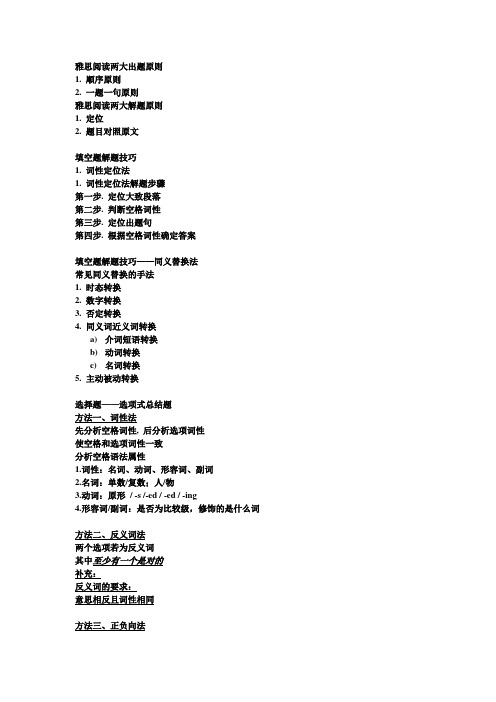
雅思阅读两大出题原则1. 顺序原则2. 一题一句原则雅思阅读两大解题原则1. 定位2. 题目对照原文填空题解题技巧1. 词性定位法1. 词性定位法解题步骤第一步. 定位大致段落第二步. 判断空格词性第三步. 定位出题句第四步. 根据空格词性确定答案填空题解题技巧——同义替换法常见同义替换的手法1. 时态转换2. 数字转换3. 否定转换4. 同义词近义词转换a)介词短语转换b)动词转换c)名词转换5. 主动被动转换选择题——选项式总结题方法一、词性法先分析空格词性, 后分析选项词性使空格和选项词性一致分析空格语法属性1.词性:名词、动词、形容词、副词2.名词:单数/复数;人/物3.动词:原形/ -s /-ed / -ed / -ing4.形容词/副词:是否为比较级,修饰的是什么词方法二、反义词法两个选项若为反义词其中至少有一个是对的补充:反义词的要求:意思相反且词性相同方法三、正负向法选项与空格的正负向必须一致方法四、近义词法几个特征相同的近义选项只有一个是对的方法五、同性质法判断空格与选项的性质(人/物),空格与选项性质必须一致选择题——选项式完成句子题方法一、词性法1. 判断上半句句末所需单词的语法属性2. 判断下半句选项打头单词的语法属性方法二、定位法第一步、找出前半句中的定位词第二步、回原文找出定位句(定位技巧: 一题一段)第三步、在题目中找出核心词第四步、核心词与原文定位句对应(核心词: 发生同意替换现象)一题一段每道题对应原文的一段话核心词的概念——决定句子核心意思的词核心词的顺序1. 最高级及绝对性词汇2. 名词(尤其是主语, 宾语)3. 动词(尤其是谓语)4. 形容词5. 副词TRUE/ FALSE /NOT GIVEN判断题解题步骤第一步、阅读题干,确定定位词,每次读两道题定位词1. 名词2. 否定词3. 逻辑关系词第二步、根据判断原则,确定答案判断原则——TRUE1.题目是原文的同义表达——采用同义词或同义结构2. 题目是对原文几句话的归纳或推断判断原则——FALSE1. 题目某些内容与原文直接相反2. 原文和题目使用了表示不同频率、可能性的词反义词:sometimes与usually, unlikely与impossible, some与all判断原则——NOT GIVEN1. 题目缩小原文的范围,但不与原文冲突2. 题目中有比较结构,原文中没有比较或比较的对象不同判断题两步走1. 判断有无矛盾有矛盾→FALSE无矛盾→TRUE/ NOT GIVEN2.第一步判断结果为无矛盾时,看范围原文小,题目大→TRUE原文大,题目小→NOT GIVEN补充万不得已时的猜题技巧1. 有may等表示委婉的词一般是TRUE补充表委婉的词may,could,might,likely,sometimes,some,not always,not all等2. 出现only等过分绝对词的选项一般为FALSE补充过分绝对词all, none, nothing, anything, every, everyone, everybody, everything, only, totally, completely, utterly, undoubtedly, absolutely, must, most, best, worst, -est3. 常考的答案组合形式三道题的答案组合:1T 1F 1NG五道题的答案组合:2T 1F 2NG六道题的答案组合:2T 2F 2NG3T 2F 1NG七道题的答案组合:3T 2F 2NG4. 极少连续三题答案都相同,没有连续四题答案都相同四选一选择题方法一、定位法——正确答案必在定位句中,任何选项中出现定位句以外的信息,均为错误答案定位词总结1. 名词2. 否定词3. 逻辑关系词4. 四个选项的共同部分方法二、正负向法方法三、排除法1. 有明显定位词的选项是干扰项明显定位词——在文中仅出现过一次的:数字,大写字母(人名,地名,机构名)2. 出现过分绝对词的选项一般不选3. 越具体越细节的选项越错,越抽象越概括的选项越对。
一位新东方雅思老师总结的雅思阅读高分经验-苗筱淋
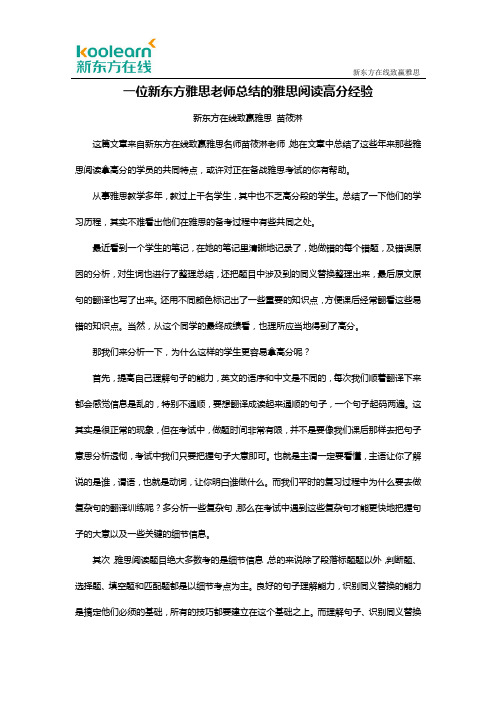
一位新东方雅思老师总结的雅思阅读高分经验新东方在线致赢雅思苗筱淋这篇文章来自新东方在线致赢雅思名师苗筱淋老师,她在文章中总结了这些年来那些雅思阅读拿高分的学员的共同特点,或许对正在备战雅思考试的你有帮助。
从事雅思教学多年,教过上千名学生,其中也不乏高分段的学生。
总结了一下他们的学习历程,其实不难看出他们在雅思的备考过程中有些共同之处。
最近看到一个学生的笔记,在她的笔记里清晰地记录了,她做错的每个错题,及错误原因的分析,对生词也进行了整理总结,还把题目中涉及到的同义替换整理出来,最后原文原句的翻译也写了出来。
还用不同颜色标记出了一些重要的知识点,方便课后经常翻看这些易错的知识点。
当然,从这个同学的最终成绩看,也理所应当地得到了高分。
那我们来分析一下,为什么这样的学生更容易拿高分呢?首先,提高自己理解句子的能力,英文的语序和中文是不同的,每次我们顺着翻译下来都会感觉信息是乱的,特别不通顺,要想翻译成读起来通顺的句子,一个句子起码两遍。
这其实是很正常的现象,但在考试中,做题时间非常有限,并不是要像我们课后那样去把句子意思分析透彻,考试中我们只要把握句子大意即可。
也就是主谓一定要看懂,主语让你了解说的是谁,谓语,也就是动词,让你明白谁做什么。
而我们平时的复习过程中为什么要去做复杂句的翻译训练呢?多分析一些复杂句,那么在考试中遇到这些复杂句才能更快地把握句子的大意以及一些关键的细节信息。
其次,雅思阅读题目绝大多数考的是细节信息,总的来说除了段落标题题以外,判断题、选择题、填空题和匹配题都是以细节考点为主。
良好的句子理解能力,识别同义替换的能力是搞定他们必须的基础,所有的技巧都要建立在这个基础之上。
而理解句子、识别同义替换都与词汇量息息相关,剑桥雅思4-11里面所涉及到的词汇是非常好的语料库,如果大家能在做题的同时,把做每个题目中涉及到的生词都及时地积累下来,那么在考试中绝对能够达到的高分所需要的词汇量。
一个很好地方法是第一次在做题的时候尽量限定时间做题,按照考试所要求的做题时间来做,之后再细细地做题并分析题目,把题目中涉及到的知识盲点全都记下来,最好整理到笔记本上,经常翻看。
英语学习方法-翁云凯—重视思路的英文牛人

英语学习方法翁云凯—重视思路的英文牛人翁云凯个人简介英语牛人翁云凯翁云凯,现任新东方精英英语全国推广中心负责人、新东方总裁助理。
曾效力于德勤会计师事务所(世界四大会计师事务所之一)担任审计师。
1999年进入新东方,2001年成为项目负责人,2003年竞聘晋升为部门主任,并且在管理过程中取得了质的飞跃。
同时期在CCTV-6《动感英语》节目中担任主持人,赢得了众多英语爱好者的欢迎和喜爱。
毕业于北京工业大学,主修国际贸易。
99年加入新东方之前,效力于德勤会计师行任审计师。
曾经执教的课程有:欢乐口语、走遍美国、美国英语、新概念、TOEFL阅读、TOEFL听力。
在基础英语教学领域,有着独到的教学思路和丰富的实战经验。
创造机会接近目标翁云凯曾经想做服装设计师,但迫于父母的压力上大学选择了当时热门的国际贸易专业。
经过两年的迷茫期,大三的时候订制了要做公司最高管理者的职业目标,并有意识的选修会计、市场营销、人力资源等课程。
做管理者的目标虽然听起来很大、很远,但翁云凯觉得条条大路通罗马。
“毕业找工作的时候,只要对目标提供有效支撑的都可以做。
”因为觉得财务知识对做管理必不可少,而自己上学期间的基础又比较欠缺,他的第一份工作选择了到德勤会计师事务所做审计师。
“他们到学校招人我没赶上,后来听宿舍同学说了我又跑到公司申请的考试。
”第二年,翁云凯发觉能学的东西都差不多了,如果沿着这条路继续做下去,“要么一直做到合伙人,要么是到一家企业去做财务总监,我都不愿意”。
想清楚之后,他辞掉了工作,准备出国读MBA深造。
在准备出国的过程中,他试着往新东方学校递了一份简历,“因为教英语对我出国读书很有。
”可能让翁云凯没想到的是,这份工作他一做就是7年,出国读书的计划被长期搁置了。
做了两年半的老师之后,2001年他开始成为项目负责人,2003年竞聘当上了部门主任,去年1月又兼任了北京学校的校长助理。
“这份工作让我看到了比计划中大的机会,干的过程中我也真正走上了管理岗位,在事实面前选择了先实践再补理论。
Fuhkjki雅思阅读选择类题型解题技巧
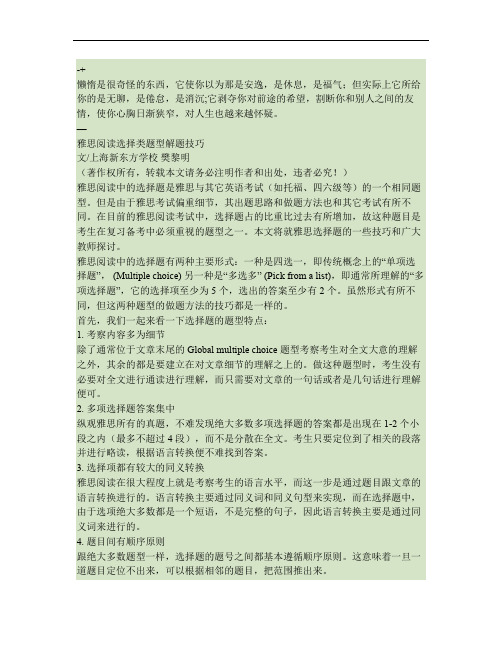
-+懒惰是很奇怪的东西,它使你以为那是安逸,是休息,是福气;但实际上它所给你的是无聊,是倦怠,是消沉;它剥夺你对前途的希望,割断你和别人之间的友情,使你心胸日渐狭窄,对人生也越来越怀疑。
—雅思阅读选择类题型解题技巧文/上海新东方学校樊黎明(著作权所有,转载本文请务必注明作者和出处,违者必究!)雅思阅读中的选择题是雅思与其它英语考试(如托福、四六级等)的一个相同题型。
但是由于雅思考试偏重细节,其出题思路和做题方法也和其它考试有所不同。
在目前的雅思阅读考试中,选择题占的比重比过去有所增加,故这种题目是考生在复习备考中必须重视的题型之一。
本文将就雅思选择题的一些技巧和广大教师探讨。
雅思阅读中的选择题有两种主要形式:一种是四选一,即传统概念上的“单项选择题”, (Multiple choice) 另一种是“多选多” (Pick from a list),即通常所理解的“多项选择题”,它的选择项至少为 5 个,选出的答案至少有 2 个。
虽然形式有所不同,但这两种题型的做题方法的技巧都是一样的。
首先,我们一起来看一下选择题的题型特点:1. 考察内容多为细节除了通常位于文章末尾的 Global multiple choice 题型考察考生对全文大意的理解之外,其余的都是要建立在对文章细节的理解之上的。
做这种题型时,考生没有必要对全文进行通读进行理解,而只需要对文章的一句话或者是几句话进行理解便可。
2. 多项选择题答案集中纵观雅思所有的真题,不难发现绝大多数多项选择题的答案都是出现在 1-2 个小段之内(最多不超过 4 段),而不是分散在全文。
考生只要定位到了相关的段落并进行略读,根据语言转换便不难找到答案。
3. 选择项都有较大的同义转换雅思阅读在很大程度上就是考察考生的语言水平,而这一步是通过题目跟文章的语言转换进行的。
语言转换主要通过同义词和同义句型来实现,而在选择题中,由于选项绝大多数都是一个短语,不是完整的句子,因此语言转换主要是通过同义词来进行的。
【威学教育】名师王鑫:雅思阅读短期提高技巧和方法【创意版】
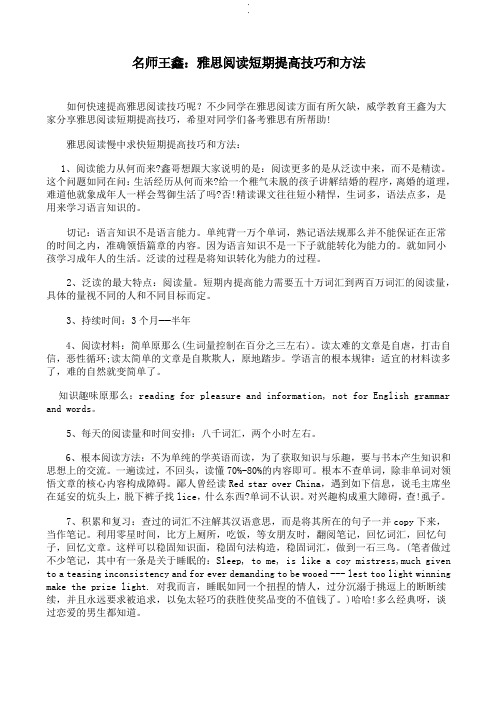
名师王鑫:雅思阅读短期提高技巧和方法如何快速提高雅思阅读技巧呢?不少同学在雅思阅读方面有所欠缺,威学教育王鑫为大家分享雅思阅读短期提高技巧,希望对同学们备考雅思有所帮助!雅思阅读慢中求快短期提高技巧和方法:1、阅读能力从何而来?鑫哥想跟大家说明的是:阅读更多的是从泛读中来,而不是精读。
这个问题如同在问:生活经历从何而来?给一个稚气未脱的孩子讲解结婚的程序,离婚的道理,难道他就象成年人一样会驾御生活了吗?否!精读课文往往短小精悍,生词多,语法点多,是用来学习语言知识的。
切记:语言知识不是语言能力。
单纯背一万个单词,熟记语法规那么并不能保证在正常的时间之内,准确领悟篇章的内容。
因为语言知识不是一下子就能转化为能力的。
就如同小孩学习成年人的生活。
泛读的过程是将知识转化为能力的过程。
2、泛读的最大特点:阅读量。
短期内提高能力需要五十万词汇到两百万词汇的阅读量,具体的量视不同的人和不同目标而定。
3、持续时间:3个月——半年4、阅读材料:简单原那么(生词量控制在百分之三左右)。
读太难的文章是自虐,打击自信,恶性循环;读太简单的文章是自欺欺人,原地踏步。
学语言的根本规律:适宜的材料读多了,难的自然就变简单了。
知识趣味原那么:reading for pleasure and information, not for English grammar and words。
5、每天的阅读量和时间安排:八千词汇,两个小时左右。
6、根本阅读方法:不为单纯的学英语而读,为了获取知识与乐趣,要与书本产生知识和思想上的交流。
一遍读过,不回头,读懂70%-80%的内容即可。
根本不查单词,除非单词对领悟文章的核心内容构成障碍。
鄙人曾经读Red star over China,遇到如下信息,说毛主席坐在延安的炕头上,脱下裤子找lice,什么东西?单词不认识。
对兴趣构成重大障碍,查!虱子。
7、积累和复习:查过的词汇不注解其汉语意思,而是将其所在的句子一并copy下来,当作笔记。
2019年雅思金牌讲师韩梅阅读实战指导(上)-word范文 (1页)

2019年雅思金牌讲师韩梅阅读实战指导(上)-word范文本文部分内容来自网络整理,本司不为其真实性负责,如有异议或侵权请及时联系,本司将立即删除!== 本文为word格式,下载后可方便编辑和修改! ==雅思金牌讲师韩梅阅读实战指导(上)主持人:各位网友大家好!嘉宾韩梅老师您好,非常荣幸今天请到雅思阅读名牌教师韩梅老师到搜狐做客,给各位雅友讲一讲阅读考试的注意事项,下面请韩梅老师给大家做一个自我介绍。
韩梅:各位网友好,主持人好,在新年到来之际,我能够做客搜狐网站跟大家探讨雅思考试各方面的问题感觉很荣幸,平常都是面对面跟学生交流,能有这个机会跟无数的未蒙面的朋友交流,也是一个难忘的经历,我从事雅思阅读教学将近4年左右的时间,所以对这方面还是有一些感想,也希望我的经验能够给大家起到好的作用。
对大家有所帮助。
网友:韩老师,考雅思阅读一般需要多少词汇量?韩梅:雅思考试和我们所熟悉的四、六级考试不太一样,四、六级考试或者大学考试都有一个教学大纲,而且其中也包括考试词汇量,但雅思考试委员会并没有公布词汇量的表。
根据以往的经验,应该具备8000左右的词汇量,这样应答起来会比较自如。
另外如果能够取得比较高分数的话,还要有一些猜测词义的能力,也就是潜在的词汇量不止这些。
网友:请问韩老师,据说考阅读只要看选项就能够答对答案,如果你经过培训的话。
是这样吗?韩梅:我不知道这位网友是从哪儿听到这个说法的,但我个人并不这么认为,因为雅思考试与我们所熟悉的四选一的阅读考试有本质的区别。
四选一的考试因为选项都是给出来的,属于客观题,我们可以通过分析选项之间的分析,还有选项中出题人的语气,能够进行一些猜测,但雅思最大的特点就是这种题尽量的少,可以说它在八个题型当中,主观题占了一半,必须考生到原文里面阅读,找原文里面的词把答案答对,所以起码这四种题型根本就没有选项去参考的。
另外四种客观题,也就是有选项的题,通常也是选项多于题目,这样单凭猜测猜对的机率也是很小的。
- 1、下载文档前请自行甄别文档内容的完整性,平台不提供额外的编辑、内容补充、找答案等附加服务。
- 2、"仅部分预览"的文档,不可在线预览部分如存在完整性等问题,可反馈申请退款(可完整预览的文档不适用该条件!)。
- 3、如文档侵犯您的权益,请联系客服反馈,我们会尽快为您处理(人工客服工作时间:9:00-18:30)。
List of headings前戏:①给段落标号②划掉用过headings③划掉相应段落解题步骤:1.通读2.读headings3.读文章4.比较解题1.通读(确定topic)TitlePictureSkimming首二句2.读Headings小前戏:直接排除不符合文章主题的headings1.Some2.过于具体(数字)3.突显价格昂贵目的: 每个heading至少找出一个KWKey Words四原则一.KW首先应该是和主题相关的名词二&三. Twins原则&三胞胎原则(2选一&3选2) “and”选项四.文章套路感揭示文章结构的名词①首段对应词1.view/conception/definition/introduction/essence/explanation/notion/core/main idea+文章的TOPIC2. what is/ what makes/ what leads to+文章topic3. defy, justify+文章topic4. basic, intrinsic, fundamental +factors, elements + of +文章topic②末段对应词effect(affect)/influence/impact/prediction/future/prospect/outlook/perspective/conclusion/res ult/challenge/consequence/aftermath/…+文章的TOPIC③主体特殊词1.金钱:income/expenditure/expense/financial/business/salary/wage/cost/commercial/ revenue/dealing/purchase2.数字:figure/number/amount/statistic(al)/data/demographics/calculation/census3.百分比:rate/ratio/proportion/percentage/density4.时间:time/period/century/ages/decades/ generation/duration/tradition/heritage/process/ procedure3.读文章各段主题句,找出关键词•段落首二句•段落末句•顺承关系:in addition, moreover, furthermore, besides, not only…but also…•转折关系but, however, yet, nevertheless…•总结关系thusa.直接解释法定义句型:A is defined as … / A is known as… A is called as …/ A isreferred to ly / That is …/ This is …/b.例子解释法例子及其LEADING SENTENCEfor instance / for example/ such as / like / to illustrate /specifically★求助于段落中的”高频词”4.比较解题万能标记法"万能标记法"旨在帮助阅读能力短期难有大幅提高的同学在短时间内,通过快速扫描将文章中90%的考点机械性的准确标记出来.然后根据课堂介绍的原则,将题目迅速回文定位解决题目.注:个人原创,欢迎转载,但请注明出处--北京新东方学校英联邦项目梅晗一.在词下方做标记1.表示次序关系递进关系: also, apart from, besides, moreover, furthermore, too...时间先后: later, before, after, since, when, until, first, second, next, at last, eventually, finally, ultimately, previous...排列次序: another, the other, additional, even more…在词下面划横线2.表示比较关系对比转折: but, however, though, although, despite, in spite of, while, rather than, yet, nevertheless, on the other hand...相似关系: like, similar to, as, in the same way, or...在词下画三角△3.表示因果关系as, because, for, since, owing to, thanks to, lead to, as a result, result in, consequently, therefore, thereby, thus, hence, so, cause...在词下画圈○4.表示举例说明关系that is to say, in other words, specifically, e.g. such as, for example, for instance...将(词)括起来5.表示特殊含义最高级–est, most, best, extreme...比较级–er, more, better, superior, inferior, preferable, as... as...唯一性only, unique, single, merely, barely, exclusively...绝对化all, every, none, impossible, immediately, never, seldom, always, totally...在词下划波浪线∽6.表示目的关系in order to, so as to...在词下划双横线二.写在文旁的人名大写地名专有名词大写名词首字母提炼(人名注意名和姓是否同时出现,并写在同一行)三.在文上做标记观点,概念及表明观点的词:idea, thought, concept, view, opinion, belief, perspective, explanation, prediction, result, consequence, outcome, summary, aftermath...notice, indicate, show, say, believe, tell, suggest, allege, conclude, appear to, think, point out, argue, remark, note, report, reason, discover, propose, imply, study, refute, claim…直接将单词用直线划掉时间打上方框(文字表述的写出数据)数字,特殊符号圈出来四.在词上方做标记表示态度的形容词/副词/动词标正负号⊕:advantageous, important, good, positive, effectively, praise, useful, famous…Θ:strange, difficult, disappointing, harmful, shameful, pessimistic…surprisingly, ironically…ignore, blame, doubt, reject, question, balk…对于目标分数较低考生,推荐在解决一篇阅读文章之前,先花6分钟左右的时间用万能标记法将文章考点标记出来,然后再按照课堂介绍步骤读题解题.对于目标分数较高考生,推荐在按照课堂介绍方法匀速扫读文章的同时快速做好标记,时间控制在8分钟左右,然后再按照课堂介绍步骤读题解题.Practice makes perfect,方法再好,自己如果不练习,考场上也是用不出来的,大家一起加油!!北京新东方学校国外考试部英联邦项目梅晗文章结构阅读法(Optional)1.介绍性说明文Title:名词短语以How/What开头的疑问句结构组成:-介绍现象/事实;-细节描述:a.Timelineb.Different Aspectsc.Logic Development-展望未来/总结环境自然类-介绍现象-导致原因-带来的影响-解决办法/展望未来2.辩论性论文(较难)(1)实验类(2)逻辑论证类(难…)(1)实验类-Introduce Experiment-Pre-experiment(Subjects, Tools, Methods)-Experiment Process-Result (Collecting Data)-Analyses and SynthesesMatching•一. 归类配对题•两步定位(粗定位, 细定位)1. 从属关系配对标志:a.题目说明有Classify, Match…b.题干或选项具有明显的同一属性用明显同一属性的信息确定原文范围用另一组信息定位查找2. 人名与观点/作为配对标志:题干或选项是人名用人名确定范围用观点or作为里的KW配合定位3. 选填图题•二. 段落信息配对题(难)1. 分析各题干,划KW2.以段为单位skimming核心词汇&细节信息3.先做该段细节题,再做信息配对4.不能确定时,move on…利用题干预测①题干中有以下信息,则一般为文章前两段概念解释(notion/explanation),身份介绍(identity),概述(overview),首次(first)…②题干中有以下信息,则一般为文章末段影响(effect),结果(conclusion),改进(improvement),建议(suggestion),未来目标(aim/future)…③首个信息一般对应靠后段落True/False/Not Given注意和要求1. 画出要求2. 每次同时查找两道题FalseF1 反义词否定词:not / no longer / not any more / by no means…隐含否定:independent/ used to do sth. / until recently/ as was once the caseF2 绝对等于不对impossible(ly) / immediate(ly)/ always / often / usually / never/ all / every / any / none must及absolutely/ definitely/ invariably/ inevitably/ unarguably/ irrefutably/ assuredly/ indisputably/ undeniably/ certainly/ without question/ out of question…F3 单一等于不对only one/only/sole/solely/single/unique/ exclusively…F4 already+完成时等于不对F5数字做考点(mainly, largely)F6 bestF7去掉条件状语Not GivenNG1 形散神必散型NG2 子虚乌有型NG3 隐含型NG4 不存在的比较关系NG5 权威效应,大众效应NG6 偷换概念NG7 原文部分提及,却有两种可能“全True法”By 乐静☺True↗同义词(相同----同义----同向)↗与”绝对”FALSE相对型possible(ly)/ probable(ly)/ presumably/ perhaps/ be likely to/ maybe/ may(might)/ can(could)/ would/ somewhat/ seem to/ appear to/ chances/ odds/ almost/ sometimes/ some/ certain/ a degree of/ occasionally/ not always/ not all/ not necessarily/↗由例子推出合理结论型推理题”四原则”1“同义转化”2只能使用最普通的逻辑3只能在原文证据范围内进行4只能进行一步↗由隐喻到直白型Multiple Choice形式:a.四选一b.七选三or 五选二c.十一选五特点:1.没有最好只有更好特点二:注意TWINS以及超生选项特点三:善待”change”选项特点四:怀疑与原文看似一致的选项正确选项=原文相关语句的改写特点五:简单题—找对应难题—”排除法”特点六:主旨标题题读文章首末句特点七:题目依顺序原则特点八:单选题对应规则为文后第一题,对应前半部分为最后一题,则对应后半部分特点九:题目中的NOT/EXCEPT特点十:both…and, all of the aboveall of the above>both…and>单一选项解题步骤:1.划掉用过的选项(多选)2.题干SW,定位回段落3.选项SW,回文中定位4.比较选项,对照原文,解题主观题What is 主观题?1.Summary (大S)2.Sentence Completion (小S)3.Short Answer Question (小小S)4.Flow Chart5.Table Completion6.Picture Naming (Matching中介绍过)Steps One:读题1.题目要求段落,NB2.通读Summary万能标记3.预测答案名词:可数?单复数?正负向?大小写? 动词:时态(原形/分词);语态(主动/被动) Step Two:定位解题1.S首句定位段落2.SW精确定位Step Three: Check。
